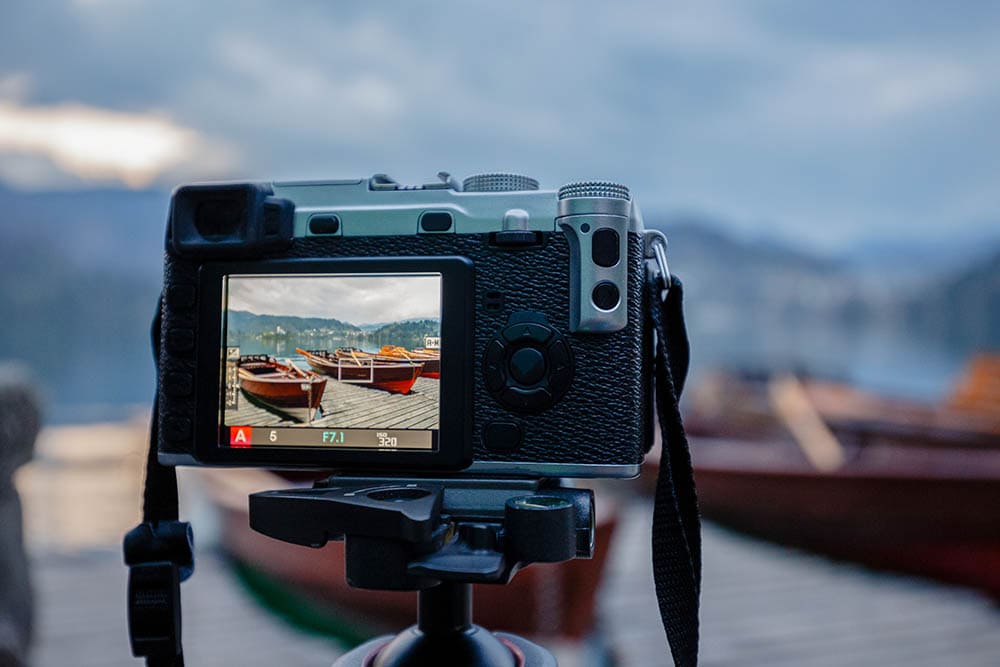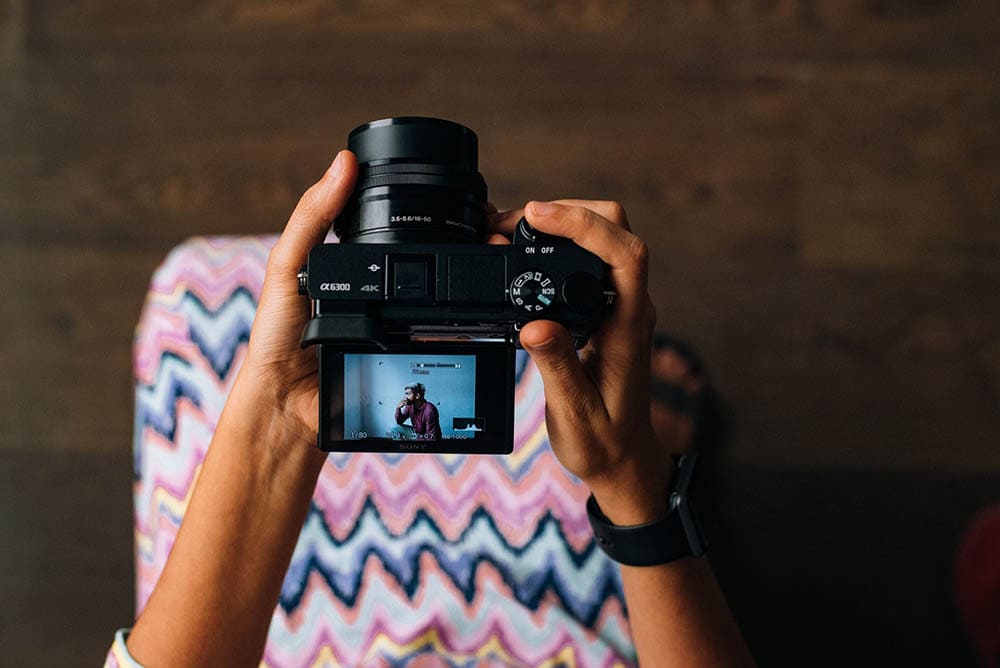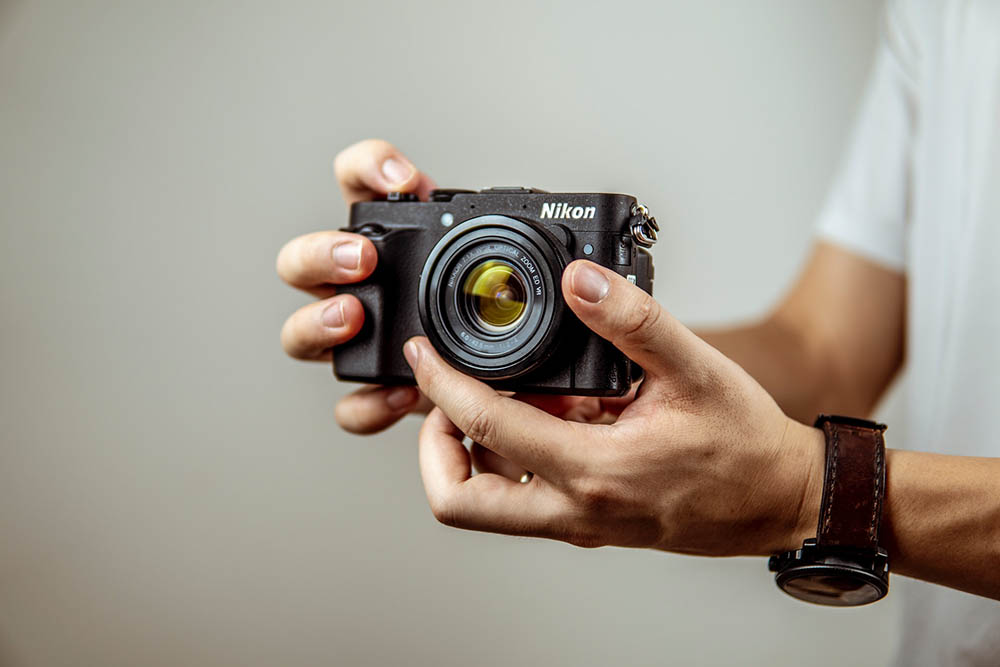What Is a Mirrorless Camera? Photography Basics Explained
Last Updated on

As you might have guessed from the name, mirrorless cameras lack an internal mirror. More specifically, they lack a reflex mirror. SLRs, or Single-lens Reflex cameras, contain a small mirror that sits between the lens and the film (or the digital sensor in DSLRs). The reflex mirror reflects light into an optical viewfinder so that the photographer can see the frame they’re about to capture.
By removing the reflex mirror, companies have been able to produce interchangeable lens cameras that are more compact, and lightweight. But portability is not the only advantage of using a mirrorless camera. While some people may still prefer to look through an optical viewfinder, mirrorless cameras come with many benefits.
In this article, we’ll take a look at all the advantages and disadvantages of using a mirrorless camera, versus a DSLR, so you can pick which one suits you best.

How Does it Work?
When light enters through the lens of a mirrorless camera, it hits the digital sensor directly, creating a live preview of the image you’re about to take. This image is usually displayed on an LCD screen at the back of the camera.
Unlike DSLRs, mirrorless cameras do not have an optical viewfinder. Some mirrorless cameras don’t have a viewfinder at all, especially the lower-end models. More advanced models usually feature an electronic viewfinder, which is a small digital screen that displays the same image as the larger LCD or OLED screen on the back of the camera. This can be especially beneficial if you’re using the camera in bright daylight when the sun makes it difficult to see the LCD display properly.
When the shutter button is pressed, the camera captures an exact duplicate of what you are viewing through the electronic viewfinder. This preview includes the effects of any contrast, exposure, or saturation settings, which you wouldn’t usually see through an optical viewfinder.

Advantages of Mirrorless Cameras
By eliminating the reflex mirror, companies have been able to produce increasingly compact and portable cameras that can deliver the same or even better-quality photographs than DSLRs. But there are other reasons why you might opt for a mirrorless camera.
Aside from their compact size, the most notable advantages of using a mirrorless camera are:
- Advanced image stabilization
- Electronic viewfinder
- Silent shutter
- Touchscreen LCD
- Fast autofocus and focus tracking
Advanced Image Stabilization
In-built image stabilization features exist in most modern DSLR and mirrorless cameras. It’s also known as IBIS or In-body Image Stabilization. Its job is to shift the lens in the opposite direction to any shaking or movement of the camera body, helping you capture sharper images.
But, even with image stabilization, if you’ve ever used a DSLR to take a long exposure shot without a tripod, chances are the results were a blurry, if artistic, mess. The image stabilization on DSLR cameras, and most low-end mirrorless cameras, are only able to act along two axes. They can counteract shaking from side to side, and up or down.
High-end mirrorless cameras, on the other hand, have advanced 5-axis image stabilization. These cameras can handle all of the above shaking movements, plus tilting (pitch and yaw) and roll.
The advantage of an advanced image stabilization feature is that you can take long, high-exposure shots, without worrying about blur. These cameras are especially useful if you want to avoid using a tripod, or if you’re on a moving object such as a boat or vehicle.

Electronic Viewfinder
This is probably one of the most obvious benefits of using a mirrorless camera. With an optical viewfinder, what you see is not always what you’ll get in the photograph. That’s because the effects of elements such as contrast, saturation, ISO, and exposure settings, cannot be seen until the camera has captured the image.
With the Electronic Viewfinder (EVF) of a mirrorless camera, you get to see a live rendering of all the settings as you select them, so you can make sure your photograph turns out exactly how you want before you’ve even taken a single shot.
EVFs are a great learning tool too. If you’re still discovering all the different settings and what effects they have on your photography, being able to see how the image is manipulated in real-time is a great visual aid.
Silent Shutter
The mechanical element of the reflex mirror being slapped away when pressing the shutter button creates noise. Combined with the shutter curtains, taking a photo can be loud enough to spook away birds and other animals that you might want to take photos of.
With a mirrorless camera, the sound of the mirror being flipped is eliminated, and on models with an electric shutter, a silent mode can be switched on. This makes mirrorless cameras virtually silent. Here are a few scenarios when the near-silence and unobtrusiveness of mirrorless cameras are of huge benefit:
- Wildlife photography
- Quite performances, like a dance or music
- Weddings, especially during vows and speeches
- Press conferences and interviews
- Quiet sports, like golf
Touchscreen LCD
The touchscreen LCD or OLED screens on some mirrorless cameras allow you to autofocus at a touch. Combined with live rendering, this feature allows you to hold the camera away from your face, at all kinds of fun angles.
Another benefit of this feature is that it makes shooting videos a lot easier. Most mirrorless cameras are capable of taking 4K videos, while some can shoot in 8K.
Faster Autofocus and Focus Tracking
In DSLR cameras, it is easier for the camera to autofocus on an object that’s in the center of the frame. This means that you will have to spend more time manually focusing on an object that’s off-center or moving across the frame.
One of the best features of mirrorless cameras is their autofocus functionality. Phase detection and contrast detection on these cameras means that no matter where the subject is within the frame, even along the border, the mirrorless camera can autofocus, fast.
Focus tracking will keep autofocus locked on a moving object, leaving you to focus on composition and exposure settings.

Disadvantages of a Mirrorless Camera
Some photographers prefer to look through an optical viewfinder and frame their shot based on what is actually there, versus the processed result. Others like the weightier feel of their DSLRs, and many photographers report that they like hearing, and sensing the mechanical movement of the mirror and shutter when capturing images. Aside from these personal preferences, there are some drawbacks to consider, when it comes to using mirrorless cameras.
Battery Life
Owing to the fact that they have more digital components than DSLRs, mirrorless cameras need more power. This means that they will use up their batteries significantly faster than a DSLR, though you can simply remedy this by carrying a few extra backups.
Highly Priced
Mirrorless cameras tend to cost more than DSLRs. When combined with buying extra batteries and other accessories, it can be a pricey investment.
Another aspect to keep in mind is that mirrorless cameras work best with native lenses, designed for use with mirrorless cameras. This selection is limited in comparison with DSLR lenses. You can use DSLR lenses with mirrorless cameras, but you’d need to invest in an adaptor first. Although, for best results, it’s recommended that you use mirrorless lenses.

Conclusion
Mirrorless cameras have become an important player in the world of photography. Its modern engineering gives it an edge over DSLRs when it comes to aspects such as autofocus, silence, and image stabilization. The elimination of the reflex mirror means that mirrorless cameras are often compact, lightweight, and portable.
Overall, if you’re into photography, it’s worth considering a mirrorless camera when looking at your options!
Featured Image Credit: Fesus Robert, Shutterstock
About the Author Cheryl Regan
Cheryl is a freelance content and copywriter from the United Kingdom. Her interests include hiking and amateur astronomy but focuses her writing on gardening and photography. If she isn't writing she can be found curled up with a coffee and her pet cat.
Related Articles:
What Is the Best Binocular Magnification for Hunting? Optical Features Explained
How to Clean a Refractor Telescope: Step-by-Step Guide
How to Clean a Telescope Eyepiece: Step-by-Step Guide
How to Clean a Rifle Scope: 8 Expert Tips
Monocular vs Telescope: Differences Explained (With Pictures)
What Is a Monocular Used For? 8 Common Functions
How to Clean a Telescope Mirror: 8 Expert Tips
Brightfield vs Phase Contrast Microscopy: The Differences Explained
